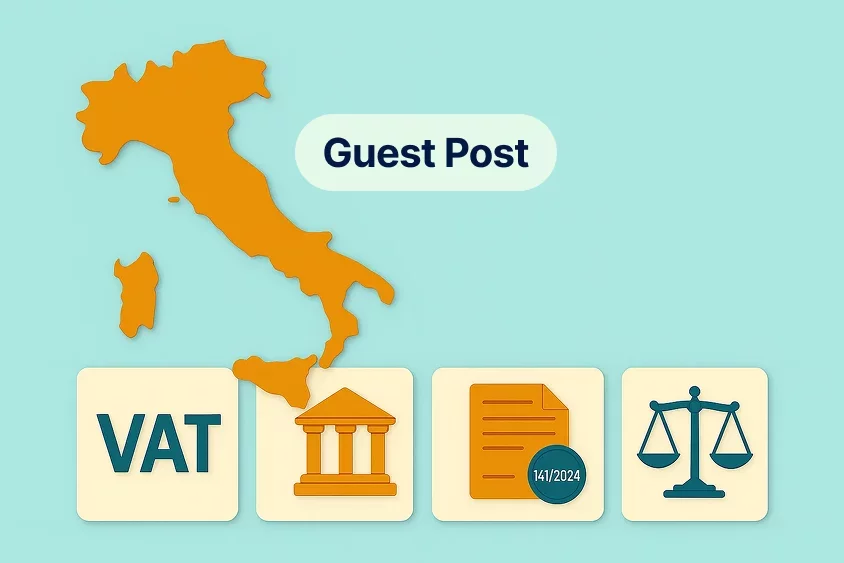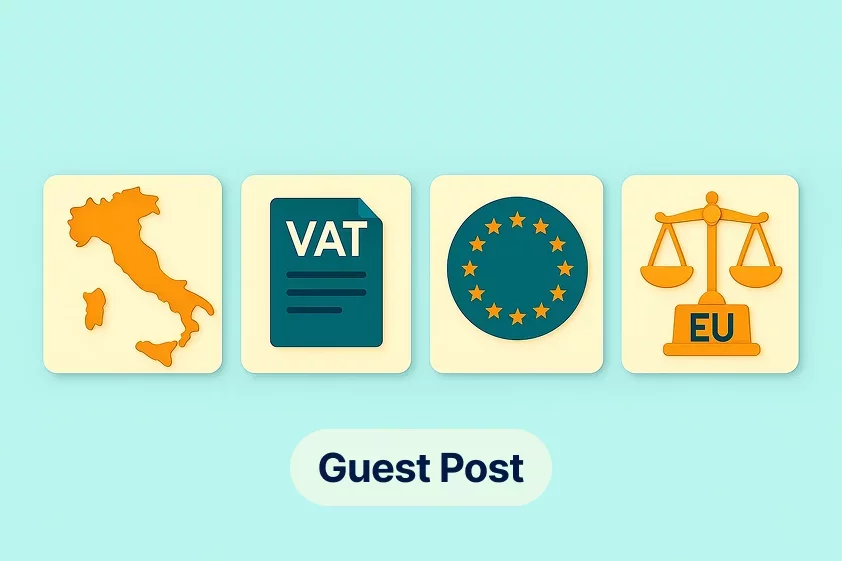Italy's VAT Reform: Legal Implications of Legislative Decree No. 141/2024

🎧 Vous préférez écouter ?
Obtenez la version audio de cet article et restez informé sans lire - parfait pour le multitâche ou l'apprentissage en déplacement.
Legislative Decree No. 141/2024 came into force on 4 October 2024, introducing changes to Italy’s VAT on importation regime and reclassifying it as a ‘border duty’. The legislation incorporates the Union Customs Code (UCC) and replaces the Consolidated Text of Customs Laws (Testo Unico delle Disposizioni Legislative in Materia Doganale, hereafter referred to as TULD), as set out in Presidential Decree No. 43/1973.
This reform marks a historic turning point in Italian customs law by repealing the TULD, aligning it with the UCC and revising the sanctions system, while also introducing the EU single window for customs. The reform also proposes a new division of responsibilities between the Customs Agency, the Revenue Agency, and other control authorities. The result is undoubtedly a more coherent and modern regulatory framework aligned with European standards, though it has received some criticism in its current form, as we shall see.
One of the main innovations is that article 27 of Legislative Decree No. 141/2024 explicitly includes VAT on importation among the so-called ‘border duties’, except in cases of release for free circulation without VAT payment due to consumption in another EU Member State (Regime 42) or release for free circulation without VAT payment, subject to a deposit regime other than a customs warehouse (Regime 45). Additionally, article 67 of Presidential Decree No. 633/1972 introduces a new paragraph (2-quater), which requires the provision of security equivalent to the amount of suspended VAT.
When VAT on importation Does Not Constitute a Border Duty
Despite the general principle of classifying VAT on importation as a border duty, there are important exceptions. Specifically, under customs Regimes 42 and 45, VAT on imports is not considered a border duty because the goods are intended for transfer to another EU Member State where the reverse charge mechanism applies.
More precisely:
Regime 42 applies to the import of goods into an EU Member State for immediate transfer to another EU Member State. In this case, VAT is not collected at the border, but instead in the destination country. This regime facilitates intra-EU trade by reducing the administrative and financial burdens associated with advance VAT payments. However, specific documentation and tracking procedures must be followed to benefit from this regime, including a declaration confirming the transfer to the destination country within the timeframes set by applicable regulations.
Regime 45 applies to the import of goods destined for VAT-registered entities in another EU Member State, again without VAT being applied at the border. Similar to Regime 42, it is often referred to as the 'VAT warehouse' regime. VAT is also accounted for in the final destination country here, offering comparable advantages in terms of simplifying fiscal procedures and reducing financial obligations. Importers must ensure that the goods are genuinely intended for VAT-registered entities in another EU Member State and that all supporting documentation is accurate and complete.
Accordingly, the Italian Customs and Monopolies Agency clarified in Circular No. 20/2024 that VAT is considered a ‘border duty’ only in cases of irregular release for consumption in Italy. This specifically occurs under regime 42 when there is no evidence that the goods were released for consumption in another EU Member State, nor proof that the goods left Italian territory; and under regime 45, when the goods were not properly recorded in the accounting of the VAT warehouse.
These exceptions confirm that the classification of VAT as a 'border duty' is conditional. They also give rise to initial interpretative and operational uncertainties, particularly in the event of disputes with Customs Authorities, as will be discussed further below.
The Legal Nature of Import VAT: Challenges of the Italian Reform in Light of EU Law
The Court of Justice of the European Union (CJEU) has provided important guidance on the nature of VAT on importation and how it differs from customs duties. This was particularly evident in its judgment in U.I. (Représentant en douane indirect) (C-714/20), in which the CJEU clarified that VAT cannot be treated as an EU own resource or as a customs duty unless explicitly designated as such by EU law. This interpretation challenges Italy’s recent reform under Legislative Decree No. 141/2024, which equates VAT on importation with customs duties and applies similar collection and sanction rules to both.
The CJEU also addressed whether indirect customs representatives can be held jointly liable for VAT on importation under article 201 of the VAT Directive. The CJEU ruled that such liability is only possible if national law explicitly and clearly designates them as liable parties. Italy responded by enacting legislation that formally imposes joint liability on both the importer and the indirect representative.
However, this approach risks violating the principle of legal certainty, a core value in both EU and Italian law. This principle demands that laws be clear, predictable, and transparent to ensure that economic operators understand their obligations. By blurring the lines between customs and VAT law, the Italian reform introduces ambiguities that may lead to conflicting interpretations by different Tax Authorities, increased legal disputes, and operational uncertainty for businesses.
The reform appears to be based on two things: a 2022 ruling by the Italian Court of Cassation that treated VAT on importation as a border duty, and the CJEU’s acknowledgement that EU Member States have discretion over who they designate as VAT debtors. However, blending the customs and VAT regimes could undermine trust in the legal system.
In practice, the reform imposes new compliance burdens. Under regime 42, importers must now provide evidence of goods being transferred to another EU Member State or risk losing financial guarantees. While exemptions exist for certified Authorized Economic Operators (AEO), the requirements remain strict. Furthermore, the reform extends criminal and administrative penalties to VAT matters. It introduces potential liabilities for indirect customs agents and raises procedural concerns about due process, especially when different sanctioning regimes overlap. These changes demand careful attention from importers to avoid penalties and navigate increasing legal complexity.
Final considerations
So, is it correct to consider VAT on importation to be a ‘border duty’?
According to the author, it is not, a conclusion supported by established CJEU case law and a recent Italian Court of Cassation ruling, as discussed throughout the article.
Over time, case law has clarified that VAT on importation cannot be equated with 'border duties', as governed by article 34 of TULD, in the same way that customs duties can be. Conversely, VAT has consistently been classified as an ‘internal tax’, as confirmed by several rulings from the Italian Supreme Court. The mechanism of VAT on importation is closely tied to the broader VAT system since it does not apply directly to the imported product itself but falls under the uniform tax framework that governs both domestic transactions within EU member states and imports.
At the European level, both VAT on importation and customs duties originate from the import of goods into the EU and their subsequent introduction into the economic circulation of EU member states. For this reason, the point at which the obligation to pay VAT on imports arises is the same as that for customs duties, even though the two types of levy are distinct in nature and function. Recent European case law has reiterated that, despite sharing some features, VAT on imports and customs duties are distinct in purpose and substance.
Article 71(1)(2) of the VAT Directive further confirms this relationship by permitting EU Member States to align the chargeability of VAT on importation with that of customs duties. Specifically, the obligation to pay VAT may arise alongside customs duties if the illegal activity that triggered the latter indicates that the goods have entered the EU market and been consumed, thus creating a taxable event for VAT purposes.
Nevertheless, VAT on importation has characteristics specific to its application. Although it does not fall within the remit of customs obligations per se, it must still be paid as part of customs procedures. In practice, VAT on imports must be paid when the customs declaration is submitted. When release for free circulation coincides with release for consumption, or in cases of irregularities in the management of VAT warehouses until goods are withdrawn, the Customs Agency is responsible for tax collection. Conversely, if unpaid VAT results from incorrect deductions on self-invoicing, responsibility for collection lies with the Revenue Agency.
Therefore, the legislative changes introduced by Legislative Decree No. 141/2024 represent a significant shift for economic operators and for the management of customs-related taxation. However, the debate is far from over, particularly if the Constitutional Court is called upon to rule on the potential unconstitutionality of article 34 of (the former) TULD, which concerns the compatibility of customs confiscation with decriminalised offences for non-payment of VAT on importation. If this happens, the reform may need to be reconsidered.
The VAT reform outlines a situation that is more theoretical than practical yet favourable to taxable persons. The consistent amendments to articles 88 and 112 of TULD are also positive. The former explicitly permits voluntary disclosure to regularise violations relevant in a criminal context.
Lastly, in line with the above analysis, there are indications that a revision of the penalty framework under Legislative Decree No. 141/2024 is forthcoming. Specifically, new thresholds may be introduced to distinguish between customs duties, which could remain at €10,000, and VAT, which could be raised to €100,000.

Articles en vedette

ECJ Ruling on VAT Margin Scheme for Artworks Supplied by Legal Entities
🕝 August 5, 2025
Affaire FedEx devant la CJCE : Violations douanières et implications en matière de TVA
🕝 July 31, 2025
Clarification de l'arrêt de la CJCE sur les biens réimportés et l'exonération de la TVA
🕝 July 17, 2025
La TVA et la décision de juin 2025 : Ce que les utilisateurs d'énergie doivent savoir
🕝 June 26, 2025Plus de nouvelles de Italie
Obtenez des mises à jour en temps réel et des informations sur l'évolution de la situation dans le monde entier, afin d'être informé et préparé.


-7xsxxoypnx.webp)
-o7f4ogsy06.webp)
-9mc55kqwtx.webp)
-jrdryw2eil.webp)
-t9qr49xs2u.webp)

-zetvivc79v.png)
-qizq6w2v5z.png)

-k1j4au0ph6.webp)
-ig9tutqopw.webp)







